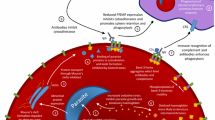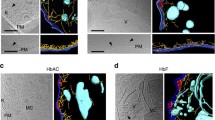Abstract
Malaria, caused by members of the genusPlasmodia, is still the most prevalent parasitic disease in the world. In an attempt to understand genetic factors conferring resistance to malaria, mouse models of thalassemia, sickle trait, and ankyrin and spectrin deficiency were studied during infection with species of malaria infectious to rodents. Although growth ofP. falciparum is not inhibited in thalassemic erythrocytes in culture, mice carrying a β-thalassemia mutation were protected fromPlasmodium chabaudi adami, supporting epidemiologic findings. Transgenic mice expressing βs hemoglobin were also significantly protected from two species of rodent malaria. Importantly, a significant role for the spleen in protection in the βs transgenic mice was found. Finally, mice deficient in spectrin and ankyrin were studied with respect to their ability to support the growth of malaria. It was found that spectrin deficient mice were almost completely refractory toP. chabaudi adami andP. berghei. These models will allow further study of host factors in resistance to malaria.
Similar content being viewed by others
References
Allison, A. C., Protection afforded by the sickle-cell trait against subtertian malaria infection. Br. Med. J.1 (1954) 290–293.
Barker, J. E., Bodine, D. M., and Birkenmeier, C. S., Synthesis of spectrin and its assembly into the red blood cell cytoskeleton of normal and mutant mice, in: Membrane Skeletons and Cytoskeletal-Membrane Associations, pp. 313–324. Ed. B. Crawford, Alan R. Liss, New York, 1986.
Barnwell, J. W., Nichols, M. E., and Rubinstein, P., In vitro evaluation of the role of the Duffy blood group inPlasmodium vivax erythrocyte invasion. J. exp. Med.169 (1989) 1795–1802.
Bernstein, S., Inherited hemolytic disease in mice: a review and update. Lab. Anim Sci.30 (1980) 197–205.
Bernstein, S. C., Bowman, J. E., and Kaptlue Noche, L., Population studies in Cameroon. Hemoglobin S, glucose-6-phosphate dehydrogenase deficiency and falciparum malaria. Human Hered.30 (1980) 251–258.
Bodine, D. M., Birkenmeier, C. S., and Barker, J. E., Spectrin-deficient hemolytic anemia in the mouse: characterization by spectrin synthesis and mRNA activity in reticulocytes. Cell37 (1984) 721–729.
Brockelman, C. R., Wongsattayanont, B., Tan-ariya, P., and Fucharoen, S., Thalassemic erythrocytes inhibit in vitro growth ofPlasmodium falciparum. J. clin. Microbiol.25 (1987) 56–60.
Costantini, F., Chada, K., and Magren, J., Correction of murine β-thalassemia by gene transfer into the germ line. Science233 (1986) 1192–1194.
Fabry, M. E., Nagel, R. L., Pachnis, A., Suzuka, S. M., Costantini, F. D., High expression of human βs and α-globins in transgenic mice: 1) Hemoglobin composition and hematologic consequences. Proc natl Acad. Sci. USA (1992) in press.
Facer, C. A., Malaria, hereditary elliptocytosis and pyropoikilocytosis. Lancet1 (1989) 897.
Fleming, A. F., Akintunde, A., Attai, E. D. E., Bradley-Moore, A. M., Greenwood, B. M., Bradley, A. K., Kirkwood, B. R., and Gilles, H. M., Malaria and haemoglobin genotype in young northern Nigerian children. Ann. trop. Med. Hyg.79 (1985) 1–5.
Flint, J., Hill, A. V. S., Bowden, D. K., Oppenheimer, S. J., Sill, P. R., Serjeanstson, S. W., Bana-Koiri, J., Bhatia, K., Alpers, M. P., Boyce, A. J., Weatherall, D. J., and Clegg, J. B., High frequencies of α-thalassaemia are the result of natural selection by malaria. Nature321 (1986) 744–750.
Friedman, M. J., Erythrocytic mechanism of sickle cell resistance to malaria. Proc. natl Acad. Sci. USA75 (1978) 1994–1997.
Friedman, M. J., Oxidant damage mediates variant red cell resistance to malaria. Nature280 (1979) 245–247.
Hoffinan, S. L., Nussenzweig, V., Sadoff, J. C., and Nussenzweig, R. S., Progress toward malaria preerythrocytic vaccines. Science252 (1991) 520–521.
Howard R. J., and Gilladoga, A. D., Molecular studies related to the pathogenesis of cerebral malaria. Blood74 (1989) 2603–2618.
Jensen, J. B., and Trager, W.,Plasmodium falciparum in culture: Use of outdared erythrocytes and description of the candle jar method. J. Parasitol.63 (1977) 883–886.
Killick-Kendrick, R., Taxonomy, zoogeography and evolution, in: Rodent Malaria, pp. 1–52. Eds R. Killick-Kendrick and W. Peters. Academic Press, London 1978.
Kolata, G., The search for a malaria vaccine. Science226 (1984) 679–682.
Landau, I., and Boulard, Y., Life cycles and morphology, in: Rodent Malaria, pp. 53–84. Eds R. Killick-Kendrick and W. Peters. Academic Press, London 1978.
Livingston, F. G., Malaria and human polymorphisms. A. Rev. Genet.5 (1971) 33–64.
Liu, S.-C., Palek, J., Prchal, J., and Castleberry, P. P., Altered spectrin dimer-dimer association and instability of erthrocyte membrane skeleton in hereditary pyropoikilocytosis. J. clin. Invest.68 (1981) 597–605.
Luce, S. A., and Miller, L. H.,Plasmodium falciparum malaria. Ultrastructure of parasitized erythrocytes in cardiac vessels. Am. J. trop. Med. Hyg.20 (1971) 655–660.
Luzzatto, L., Nwachuku-Jarrett, E. S., and Reddy S., Increased sickling of parasitized erythrocytes as mechanisms of resistance against malaria in sickle cell trait. Lancet1 (1970) 319–322.
Luzzi, G. A., Merry, A. H., Newbold, C. I., Marsh, K., Pasvol, G., and Weatherall, D. J., Surface antigen expression ofPlasmodium falciparum-infected erythrocytes is modified in α-and β-thalassemia. J. exp. Med.173 (1991) 785–791.
Macpherson, G. G., Warrell, M. J., White, N. J., Looarreesuwan, S., and Warrell, D. A., Human cerebral malaria. A quantitative ultrastructural analysis of parasitized erythrocyte sequestration. Am. J. Path.119 (1985) 385–401.
Miller, L. H., and Carter, R., Innate resistance in malaria. Exptl Parasit.40 (1976) 132–146.
Nagel, R. L., and Fleming, A. F., The genetic epidemiology of the βs gene, in: Bailliere's Clinical Haematology, Vol. 5, No. 2. pp. 331–365. Ed. A. F. Fleming. Saunders, London 1992.
Nagel, R. L., and Roth, E. F., Malaria and red cell genetic defects. Blood74 (1989) 1213–1221.
Pasvol, G., Weatherall, D. J., and Wilson, R. J. M., Cellular mechanism for the protective effect of haemoglobin S againstP. falciparum malaria. Nature274 (1978) 701–703.
Pasvol, G., Weatherall, D. J., and Wilson, R. J. M., Effects of foetal haemoglobin on susceptibility of red cells toPlasmodium falciparum. Nature270 (1977) 171–173.
Perkins, M. M., Binding of glycophorins toPlasmodium falciparum merozoites. Molec. Biochem. Parasit.10 (1984) 67–78.
Rachmilewitz, E. A., Treves, A., and Treves, A. J., Susceptibility of thalassemic red blood cells to phagocytosis by human macrophages in vitro. Ann. N.Y. Acad. Sci.344 (1979) 314–321.
Raventos-Suarez, C., Kaul, D. K., Macaluso, F., and Nagel, R. L., Membrane knobs are required for the microcirculatory obstruction induced byPlasmodium falciparum-infected erythrocytes. Proc. natl Acad. Sci. USA82 (1985) 3829–3833.
Roth, E. F. Jr., Friedman, M., Ueda, Y., Tellez, I., Trager, W., and Nagel R. L., Sickling rates of human AS red cells infected in vitro withPlasmodium falciparum malaria. Science202 (1978) 650–652.
Roth, E. F., Jr., Raventos-Suarez, C., Rinaldi, A., and Nagel, R. L., Glucose-6-phosphate dehydrogenase deficiency inhibits in vitro growth ofPlasmodium falciparum. Proc. natl Acad. Sci. USA80 (1983) 298–299.
Roth, E. F., Shear, H. L., Costantini, F., Tanowitz, H. B., and Nagel, R. L., Malaria in β-thalassemic mice and the effects of the transgenic human β-globin gene and splenectomy. J. Lab. clin. Med.111 (1988) 35–41.
Schulman, S., Roth, E. F., Cheng, B., Schwartz, R. S., Rybicki, A. C., Sussman, I. I., Wong, M., Wang, W., and Nagel, R. L., Growth ofPlasmodium falciparum in human erythrocytes containing abnormal membrane proteins. Proc. natl Acad. Sci.87 (1990) 7339–7343.
Shear, H. L., Roth, E. F. Jr., Ng, C., and Nagel, R. L., Resistance to malaria in ankyrin and spectrin deficient mice. Br. J. Haemat.78 (1991) 555–560.
Shear, H. L., Roth, E. F. Jr., Fabry, M. E., Costantini, F. D., Pachnis, A., Jood, A., and Nagel, R. L., Transgenic mice expressing human sickle hemoglobin are partially resistant to rodent malaria. Blood (1993) in press.
Skow, L. C., Burkhart, B. A., Johnson, F. M., Popp, R. A., Popp, D. M., Goldberg, S. Z., Anderson, W. F., Barnett, L. B., and Lewis, S. E., Amouse model for β-thalassemia. Cell34 (1983) 1043–1052.
Trager, W., Rudzinska, M. A., and Bradbury, P. C., The fine structure ofPlasmodium falciparum and its host erythrocytes in natural malarial infections in man. Bull. WHO35 (1966) 883–885.
Wilcox, M., Bjorkman, A., Brohult, J., Pehrson, P. O., Rombi L., and Bengtsson, E., Ann. trop. Med. Parasit.77 (1983) 239–246.
Yuthavong, Y., Bunyaratvej, A., and Kamchonwongpaisan, S., Increased susceptibility of malaria-infected variant erythrocytes to the mononuclear phagocyte system. Blood Cells16 (1990) 591–597.
Author information
Authors and Affiliations
Rights and permissions
About this article
Cite this article
Shear, H.L. Transgenic and mutant animal models to study mechanism of protection of red cell genetic defects against malaria. Experientia 49, 37–42 (1993). https://doi.org/10.1007/BF01928786
Issue Date:
DOI: https://doi.org/10.1007/BF01928786




